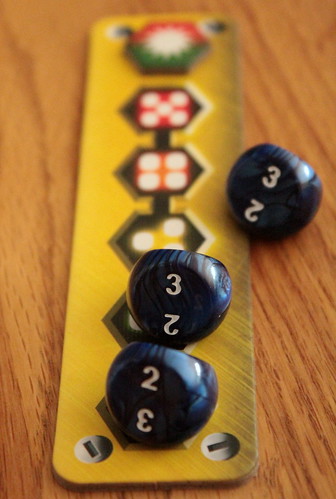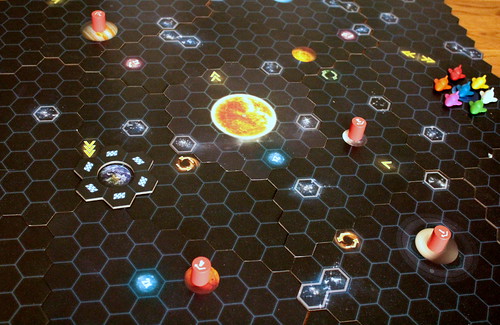| Strategy | Luck |
|---|---|
| Interaction | Components & Design |
| Complexity | Score |
Powerships is a racing game by Corné van Moorsel and a remake of his own Powerboats. There are no bells or whistles to it. You set out the course and up to seven players put their interplanetary pedal to the metal. First to the finish line wins.
In-System Navigation 101 – The Rules
Before you get to race you have to build a solar system. Assembling the modular game board is not usually a step I’d mention, but on Powerships I have a warning for the first time you play: some pieces are almost but not quite symmetrical. If you don’t use them the right way around your solar system will not be a nice, tidy hexagon as it’s supposed to be.

Once you have a solar system you need a race track. You pick a start planet, a finish planet and two to four planets to mark with buoys to pass along the way. I’ve never liked racing games where you’re supposed to come up with the route of the rate first. As far back as Robo Rally, I never liked that part. So I’m happy to tell you that Powerships has rules to quickly and easily set up a random route based on the day of the week and some dice rolls.
And then you’re ready to start. All ships start somewhere around the start planet and with no dice on their speedometers. The speedometer is where all the magic happens because, believe it or not, it tells you how fast you’re going. It has space for five dice. On your turn you may add one or remove one, giving you a tight limit acceleration and break maneuvers. Then you may turn up to sixty degrees left or right, meaning one face of the hexagonal space you’re on. And then off you go. Straight line, no fancy maneuvers, hope there’s nothing in your way.

Dice in Powerships have three sides. Plato is not happy about them. One die on your speedometer will move you one to three spaces forward. Dice already on your speedometer keep the value they have, unless you choose to reroll them. What I’m trying to say is, you have a lot of control over your speed. It’s sorely needed, too, because all those people telling you that space is mostly empty? They’re not telling you the whole truth.
Adjusting your speed slowly, turning slowly, that would be okay if there were no obstacles to avoid. But there are all sorts of things out there. Things like planets. Running into planets is bad. Same goes for random spots of stardust. Running into one of those is not ideal, either. Crashing has two downsides in Powerships. First, it removes all the dice from your speedometer. Then it moves your damage marker to block a spot on your speedometer so it now holds one fewer die until you take time to repair.
If you’re a mean, old cheater like me, then you’re already thinking that crashing doesn’t sound so bad. In a game where slowing down might take you a few turns taking repairable damage to stop immediately sounds pretty good. That’s what I thought, too. Unfortunately, crashing is not so easy. If you would crash on your chosen course for the round, and you have another valid move where you wouldn’t crash, then you have to go that way. Even worse, if all your options would make you crash you have to pick the one where you travel the longest way before crashing. Thanks to that little rule crashing is not your main problem. Avoiding a crash and being thrown off course is.
A few other special spaces make things interesting. Crossing a Space Drift pushes your ships into a given direction before you continue your movement. Gravitational Whirlpools turn your ship by sixty degrees. Warp Speed doubles your remaining movement for this turn, and Hyperspace does the same plus it lets you pass through obstacles. Especially those last two sound pretty good. I’m not gonna lie to you, when you get them on purpose they are. But when you have to avoid a crash and go entirely the wrong way at warp speed, that’s hilarious for everyone else and often an early end of the race for you.
Speaking of the end of the race, there are two ways that can go. If you’re playing a single game then you can just stop after the first player reaches the goal. They’re obviously the winner. If you’re playing a series of races and keeping track of the overall score, then you keep playing until all players reached the goal. Position and number of turns used after the first player arrived give the score for this race.
Across the finish line – The Verdict

Long story short, Powerships is a good but minimalist racing games. The mechanisms for acceleration, deceleration, and course changes aren’t exactly real space physics, but they work, they’re fun, and they’re satisfying to master. I wanted to complain that you never really get to use the fifth die on your speedometer because you’ll always overshoot and crash with it, but then I lost against a friend flying around the outer edge of the solar system at full speed for most of the game. You have to circumnavigate the buoys, but no rule says that you have to be close to them. So you have different options how to approach the race, and that’s a nice change in a racing game for sure.
It’s the minimalist part that will not work for everyone. The mechanisms to control your ship are good, but they are pretty much all there is. You race your ship around the solar system in straight lines. You get a few of those special spaces, but they are not common. This isn’t Robo Rally where spinners and conveyors are everywhere. In Powerships, those spaces are rare, and you’ll have games where you don’t hit any of them.
There is a mini expansion included that adds three comets rolling through the system. They give you some moving obstacles to avoid, which is fun, but they also add a small chance for a player to be eliminated from the game, which is not.
In all, Powerships is a mechanically solid game that mostly depends on your skill. The way dice are used I don’t even want to talk about luck. Risk management is more appropriate. Manage the risk of rolling your dice and you’ll win. Mechanically solid, but for my personal taste I’d want more things going on, more than just one mechanism to the game. But my taste is not everyone’s. If what you want is a pure racing game, mostly skill-based, quick to learn and play, then Powerships is absolutely worth a look.















